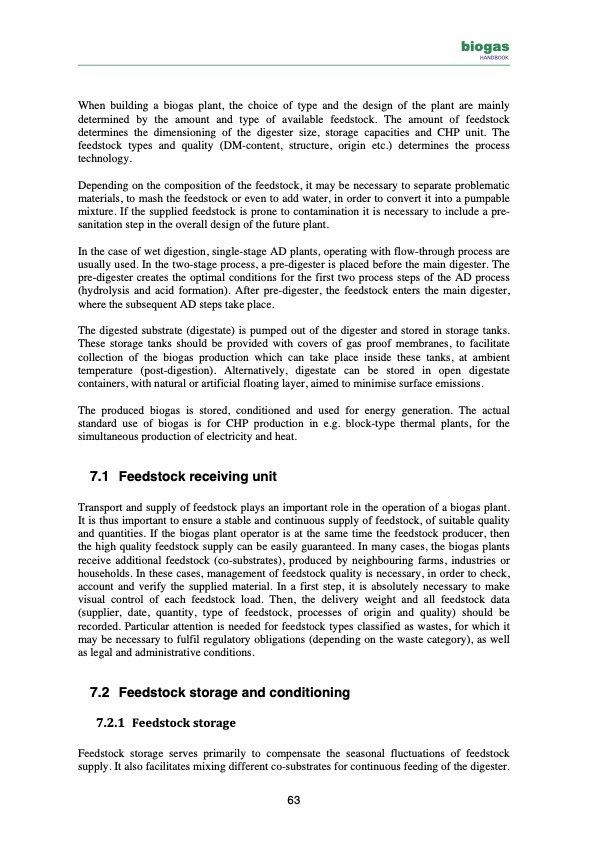
PDF Publication Title:
Text from PDF Page: 063
biogas HANDBOOK When building a biogas plant, the choice of type and the design of the plant are mainly determined by the amount and type of available feedstock. The amount of feedstock determines the dimensioning of the digester size, storage capacities and CHP unit. The feedstock types and quality (DM-content, structure, origin etc.) determines the process technology. Depending on the composition of the feedstock, it may be necessary to separate problematic materials, to mash the feedstock or even to add water, in order to convert it into a pumpable mixture. If the supplied feedstock is prone to contamination it is necessary to include a pre- sanitation step in the overall design of the future plant. In the case of wet digestion, single-stage AD plants, operating with flow-through process are usually used. In the two-stage process, a pre-digester is placed before the main digester. The pre-digester creates the optimal conditions for the first two process steps of the AD process (hydrolysis and acid formation). After pre-digester, the feedstock enters the main digester, where the subsequent AD steps take place. The digested substrate (digestate) is pumped out of the digester and stored in storage tanks. These storage tanks should be provided with covers of gas proof membranes, to facilitate collection of the biogas production which can take place inside these tanks, at ambient temperature (post-digestion). Alternatively, digestate can be stored in open digestate containers, with natural or artificial floating layer, aimed to minimise surface emissions. The produced biogas is stored, conditioned and used for energy generation. The actual standard use of biogas is for CHP production in e.g. block-type thermal plants, for the simultaneous production of electricity and heat. 7.1 Feedstockreceivingunit Transport and supply of feedstock plays an important role in the operation of a biogas plant. It is thus important to ensure a stable and continuous supply of feedstock, of suitable quality and quantities. If the biogas plant operator is at the same time the feedstock producer, then the high quality feedstock supply can be easily guaranteed. In many cases, the biogas plants receive additional feedstock (co-substrates), produced by neighbouring farms, industries or households. In these cases, management of feedstock quality is necessary, in order to check, account and verify the supplied material. In a first step, it is absolutely necessary to make visual control of each feedstock load. Then, the delivery weight and all feedstock data (supplier, date, quantity, type of feedstock, processes of origin and quality) should be recorded. Particular attention is needed for feedstock types classified as wastes, for which it may be necessary to fulfil regulatory obligations (depending on the waste category), as well as legal and administrative conditions. 7.2 Feedstockstorageandconditioning 7.2.1 Feedstockstorage Feedstock storage serves primarily to compensate the seasonal fluctuations of feedstock supply. It also facilitates mixing different co-substrates for continuous feeding of the digester. 63PDF Image | biogas HANDBOOK

PDF Search Title:
biogas HANDBOOKOriginal File Name Searched:
BiogasHandbook.pdfDIY PDF Search: Google It | Yahoo | Bing
Capstone Turbine and Microturbine: Capstone microturbines used and new surplus for sale listing More Info
Consulting and Strategy Services: Need help with Capstone Turbine, sizing systems, applications, or renewable energy strategy, we are here to assist More Info
Container Lumber Dry Kiln: Since 1991 developing and innovating dry kilns using standard shipping containers More Info
Supercritical CO2 Lumber Dry Kiln: Compact fast drying in 3 days or less for small amounts of wood and lumber drying More Info
BitCoin Mining: Bitcoin Mining and Cryptocurrency... More Info
Publications: Capstone Turbine publications for microturbine and distributed energy More Info
FileMaker Software for Renewable Energy Developing database software for the renewable energy industry More Info
CO2 Gas to Liquids On-Demand Production Cart Developing a supercritical CO2 to alcohol on-demand production system (via Nafion reverse fuel cell) More Info
Stranded Gas for low cost power Bitcoin Mining Using stranded gas for generators may provide breakthrough low power costs for cryptocurrency miners. More Info
| CONTACT TEL: 608-238-6001 Email: greg@globalmicroturbine.com | RSS | AMP |